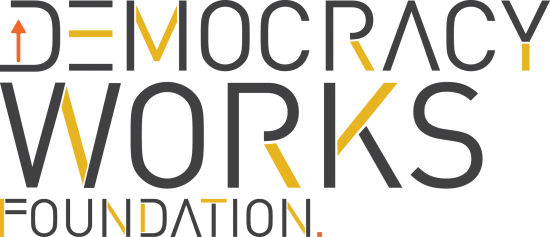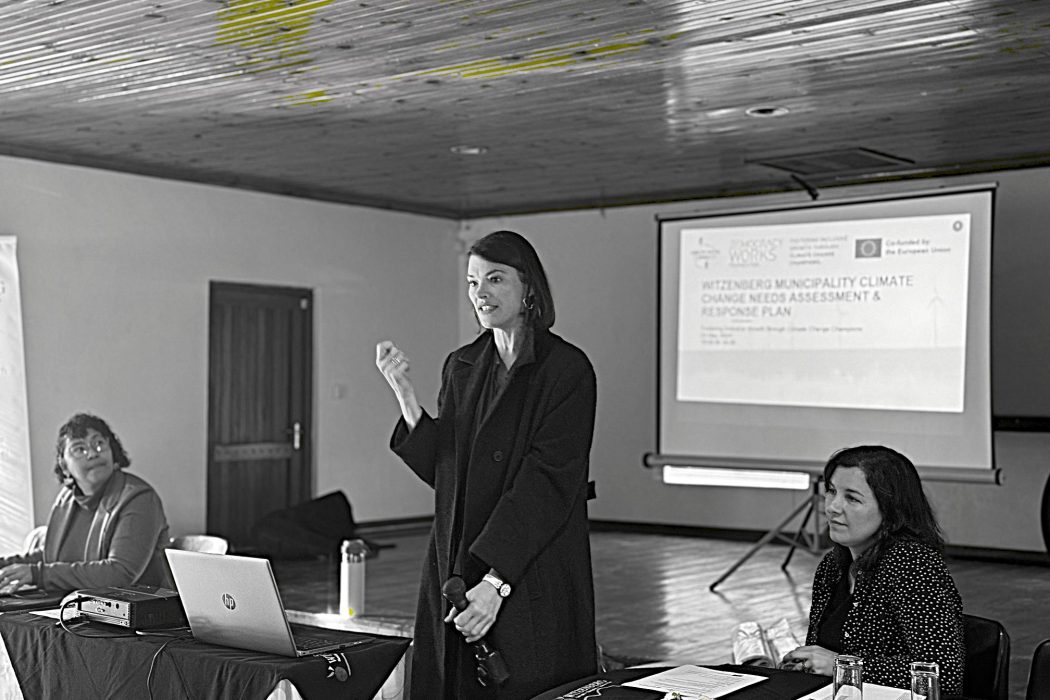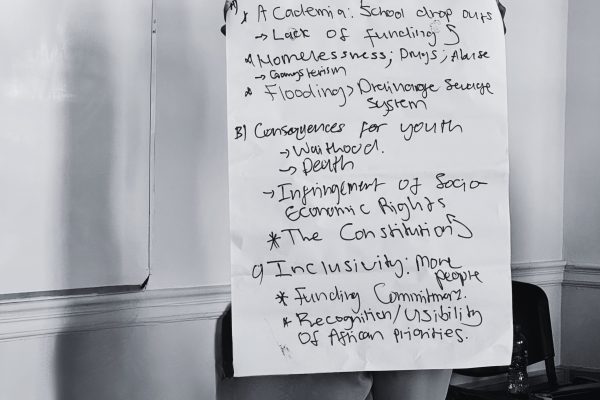Integrating community-driven climate change action into local government planning processes through a multi-stakeholder engagement process spearheaded by DWF, Green Path Connect and Witzenberg Municipality.
On 26 August, the Witzenberg Municipal Council formally adopted the municipal Climate Change Needs Assessment and Response Plans. Using publicly available tools like The Greenbook and the Let’s Respond Toolkit, DWF and Green Path Connect conducted extensive research and consultation to outline the key vulnerabilities in the Western Cape area of Witzenberg and propose municipal-level responses to address these.
The Climate for Growth project aims to support partnerships that integrate community-based climate change and development priorities into local government and private sector decision-making processes. The three-year project, co-funded by the European Union, works with civil society organisations (CSOs), local government representatives and experts in the Independent Power Producing (IPP) sector to support combining community-driven climate change responses with international mitigation funding and local-government planning.
This article focuses on the work conducted with the 4 target municipalities in the Northern and Western Cape Provinces, highlighting the success story of Witzenberg in the Western Cape. It also contains relevant links to learning tools and products for facilitating these engagement processes.
Background
One Climate for Growth project component was collaborating with municipal representatives to improve their climate literacy, deepen partnerships with civil society stakeholders, and develop multi-stakeholder municipal climate change-related plans. DWF’s journey with the Witzenberg Municipality started in 2022 when DWF hosted a municipal workshop with representatives from the management team and leadership from Witzenberg and Dawid Kruiper Municipalities in the Western Cape. Following that, the Environmental Management Team, at request from the Municipal Manager, reached out to DWF to initiate the process of developing the CCNA and the CCRP.
The launch’s timing is serendipitous, as the new Climate Change Act has recently been passed into law in South Africa. Previous policy frameworks guided municipalities to integrate climate change into their planning processes and develop CCNA and CCRP. The Act puts this into law. Thus, Witzenberg municipality is at the forefront of a process that all municipalities must undergo. The learning tools resulting from this process hope to assist other municipalities and stakeholders in these processes.
Process
DWF recruited the consultants Green Path Connect following an extensive public call for proposals, interviews and negotiations. DWF and the municipality formally signed an MoU, and then DWF and Green Path Connect agreed on a Service Level Agreement so the work could start in earnest.
The consultants initiated the process through extensive desktop research and careful application of the existing tools (Greenbook and Let’s Respond Toolkit). The draft plan was then used as a basis for extensive stakeholder engagement, with a per-invite and an open-to-public comment period.
The multistakeholder engagement was a face-to-face event held on 24 August. Climate Change Champions from Witzenberg and local, provincial and national government representatives attended, as did private sector interest groups from agriculture, the water sector, winemakers and representatives of IPPs. The team facilitated a process that allowed participants to develop a deeper understanding of climate change scenarios, predictions, and what they meant for their areas. The stakeholders engaged with the report around how the desktop research reflected their own experiences. The process had to carefully delineate those areas which fall into municipal areas of responsibility. Regarding issues that require national and provincial collaboration, the municipality’s responsibility to communicate with their government counterparts around these issues was highlighted.
The report was open for comment online for two weeks. During that time, the consultants also engaged in online discussions and focus groups with a broad range of interest groups, including experts in the IPP sector in that area. Together with the comments received, the consultants then revised the reports to integrate the input and reflect the conducted research into the final report.
The final report was workshopped internally with representatives of the council, the management team, and the environmental management and communications teams. The council was given time to consider the report and engage the team on any preliminary questions. The report was then formally presented to the Council on 26 July. The presentation included all the contacts and network opportunities opened during the process from SALGA, CSIR, and the national government. We empower citizens and leaders with tools to make democracy work in southern Africa.
DWF aims for sustainable, inclusive, consensus democracies in the region. Its projects and initiatives are focused on building this culture of grantmakers from NPOs and the private sector. Councilor Karriem Adams commended the team for the work done at the council presentation and emphasised the need for multi-sectoral partnerships around building community-based resilience. According to the mayor, the plan was a tool they could use to engage with all the departments and get them to integrate the relevant action points into the Key Performance Appraisal processes of the appropriate job descriptions to allow the municipality to track, report and refine the process. Notably, he mandated that the plan be used to inform the IDP and all other local government planning mandates. The plan was formally adopted without reservations on 26 July.
To celebrate the adoption of the plan and publicly hand the plan over to the municipal council for implementation, DWF hosted a launch on 30 July. The launch was an opportunity for the municipality to reflect and publicly endorse the process. IPP representatives, all stakeholders who were part of the first engagement and Climate Change Champions were in attendance. Councilor Adams emphasised: “The strategies in this climate change response plan need to be integrated into Witzenberg IDPs and SDG Plan. We are eager to forge partnerships with the local and global spheres to exchange knowledge further and share best practices. We are equally committed to working with our community to implement this plan for inclusive and impactful climate mitigation.”
This was a critical moment in connecting the CCNA and CCRP with opportunities and networks that opened up through this process. Lwandile Nokoyo, SALGA Senior Advisor – Municipal Sustainability and Disaster Management, formally presented the support opportunities that are available for municipalities in their efforts to implement their CCNA and CCRPs and declared his and his team’s availability and interest in continuing to work with Witzenberg. “Disaster Risk Management and Climate go hand in hand. As SALGA, we’d like to congratulate the Witzenberg Municipality and pledge our support to assist meaningfully in implementing this Plan. We urge other communities to reach out to use for their municipalities to be assessed as well,” remarked Mr Nokoyo.
DWF’s Business Development Manager, Raisa Cole, presented DWF’s vision for future climate governance work to establish potential future partnerships.
Conclusion
A key milestone for DWF’s program is adopting and handing over the results of multistakeholder knowledge co-creation processes to enhance local climate governance. However, this is the beginning of the actual work!
Plans are only as good as the paper they’re printed on. DWF has built democratic actors’ capacity and developed tools aimed at supporting them and everyone with a stake in the process to implement the ambitious projects proposed in the document. We’ve built a network of people and institutions dedicated to the implementation process with the municipality. The plan, however, needs to remain a living document. The method of engagement must continue with finding investors and funding and ensuring implementation, evaluation, and communication of the initiatives. The groundwork for creating the blueprints has, therefore, been achieved. It is now up to the network to identify and invite opportunities to collaborate and build on this milestone achievement.









